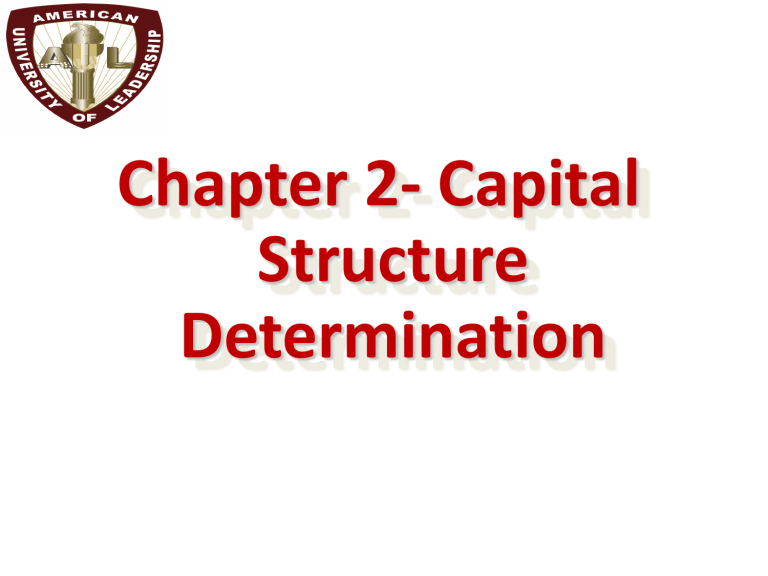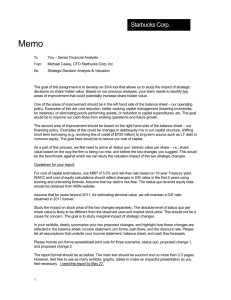Chapter 17
advertisement

Chapter 2- Capital Structure Determination After studying this chapter, you should be able to: • Define “capital structure.” • Explain the net operating income (NOI) approach to capital structure and valuation of a firm; and, calculate a firm's value using this approach. • Explain the traditional approach to capital structure and the valuation of a firm. Capital Structure Capital Structure -- The mix (or proportion) of a firm’s permanent long-term financing represented by debt, preferred stock, and common stock equity. – Concerned with the effect of capital market decisions on security prices. – Assume: (1) investment and asset management decisions are held constant and (2) consider only debtversus-equity financing. A Conceptual Look --Relevant Rates of Return ki = the yield on the company’s debt ki = I B = Annual interest on debt Market value of debt Assumptions: • Interest paid each and every year • Bond life is infinite • Results in the valuation of a perpetual bond • No taxes (Note: allows us to focus on just capital structure issues.) A Conceptual Look --Relevant Rates of Return ke = the expected return on the company’s equity Earnings available to EE common shareholders ke = S = Market value of common S stock outstanding Assumptions: • Earnings are not expected to grow • 100% dividend payout • Results in the valuation of a perpetuity A Conceptual Look --Relevant Rates of Return ko = an overall capitalization rate for the firm ko = OO VV = Net operating income Total market value of the firm Assumptions: • V = B + S = total market value of the firm • O = I + E = net operating income = interest paid plus earnings available to common shareholders Capitalization Rate Capitalization Rate, ko -- The discount rate used to determine the present value of a stream of expected cash flows. ko = ki B B+S + ke S B+S What happens to ki, ke, and ko when leverage, B/S, increases? Net Operating Income Approach Net Operating Income Approach -- A theory of capital structure in which the weighted average cost of capital and the total value of the firm remain constant as financial leverage is changed. Assume: – Net operating income equals $1,350 – Market value of debt is $1,800 at 10% interest – Overall capitalization rate is 15% Required Rate of Return on Equity Calculating the required rate of return on equity Total firm value = O / ko = $1,350 / .15 = $9,000 Market value =V-B = $9,000 - $1,800 of Interest payments equity = $7,200 = $1,800 x 10% Required return = E / S on equity* = ($1,350 - $180) / $7,200 = 16.25% * B / S = $1,800 / $7,200 = .25 Required Rate of Return on Equity What is the rate of return on equity if B=$3,000? Total firm value = O / ko = $1,350 / .15 = $9,000 Market value =V-B = $9,000 - $3,000 of Interest payments equity = $6,000 = $3,000 x 10% Required return = E / S on equity* = ($1,350 - $300) / $6,000 = 17.50% * B / S = $3,000 / $6,000 = .50 Required Rate of Return on Equity Examine a variety of different debt-to-equity ratios and the resulting required rate of return on equity. B/S 0.00 0.25 0.50 1.00 2.00 ki --10% 10% 10% 10% ke 15.00% 16.25% 17.50% 20.00% 25.00% Calculated in slides 9 and 10 ko 15% 15% 15% 15% 15% Required Rate of Return on Equity Capital costs and the NOI approach in a graphical representation. .25 Capital Costs (%) .20 ke = 16.25% and 17.5% respectively ke (Required return on equity) .15 ko (Capitalization rate) .10 ki (Yield on debt) .05 0 0 .25 .50 .75 1.0 1.25 1.50 Financial Leverage (B / S) 1.75 2.0 Summary of NOI Approach • Critical assumption is ko remains constant. • An increase in cheaper debt funds is exactly offset by an increase in the required rate of return on equity. • As long as ki is constant, ke is a linear function of the debt-to-equity ratio. • Thus, there is no one optimal capital structure. Traditional Approach Traditional Approach -- A theory of capital structure in which there exists an optimal capital structure and where management can increase the total value of the firm through the judicious use of financial leverage. Optimal Capital Structure -- The capital structure that minimizes the firm’s cost of capital and thereby maximizes the value of the firm. Summary of the Traditional Approach • The cost of capital is dependent on the capital structure of the firm. – Initially, low-cost debt is not rising and replaces more expensive equity financing and ko declines. – Then, increasing financial leverage and the associated increase in ke and ki more than offsets the benefits of lower cost debt financing. • Thus, there is one optimal capital structure where ko is at its lowest point. • This is also the point where the firm’s total value will be the largest (discounting at ko). Total Value Principle: Modigliani and Miller (M&M) • Advocate that the relationship between financial leverage and the cost of capital is explained by the NOI approach. • Provide behavioral justification for a constant ko over the entire range of financial leverage possibilities. • Total risk for all security holders of the firm is not altered by the capital structure. • Therefore, the total value of the firm is not altered by the firm’s financing mix. Total Value Principle: Modigliani and Miller Market value of debt ($35M) Market value of debt ($65M) Market value of equity ($65M) Market value of equity ($35M) Total firm market value ($100M) Total firm market value ($100M) Total market value is not altered by the capital structure (the total size of the pies are the same). • • M&M assume an absence of taxes and market imperfections. Investors can substitute personal for corporate financial leverage. Arbitrage and Total Market Value of the Firm Two firms that are alike in every respect EXCEPT capital structure MUST have the same market value. Otherwise, arbitrage is possible. Arbitrage -- Finding two assets that are essentially the same and buying the cheaper and selling the more expensive.






